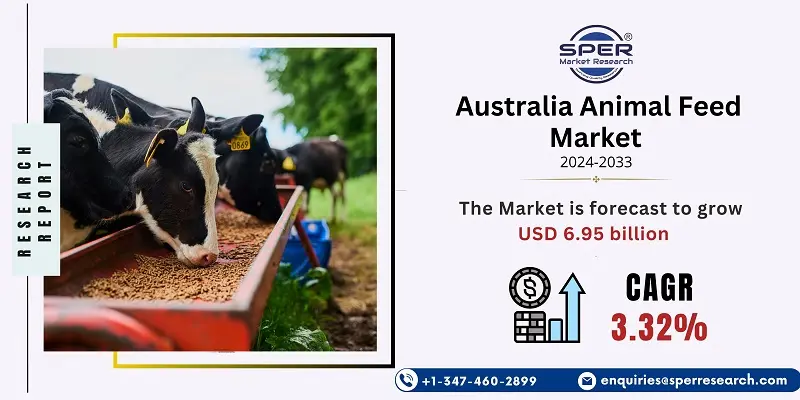
Australia Animal Feed Market Growth, Trends, Size, Demand, Share, Revenue and Future Outlook
Australia Animal Feed Market Size- By Product, By Livestock- Regional Outlook, Competitive Strategies and Segment Forecast to 2033
| Published: Jun-2024 | Report ID: FOOD2463 | Pages: 1 - 109 | Formats*: |
| Category : Food & Beverages | |||
- Cargill and BASF partnered in the animal nutrition industry in October 2021, expanding their feed enzyme distribution agreements to include new markets and enhanced R&D resources. The partnership aims to develop, produce, market, and sell animal-focused enzyme products and solutions, particularly swine products.
- Coppens Diervoeding, a Dutch feed manufacturer with a focus on pig farming, was acquired by De Heus in July 2021. De Heus intended to get 400k more regional traction and double its production capacity with this acquisition.


| Report Metric | Details |
| Market size available for years | 2020-2033 |
| Base year considered | 2023 |
| Forecast period | 2024-2033 |
| Segments covered | By Product, By Livestock |
| Regions covered | Eastern, Western, Northern, Southern |
| Companies Covered | Charoen Pokphand Foods PC, Cargill Incorporated, ADM Animal Nutrition, Alltech Inc, Novus International, DSM Nutritional Products AG, Evonik Industries AG, BASF SE, Lallemand Inc, Zinpro Corp, Others |
- Livestock Farmers
- Pet Owners
- Feed Producers
- Veterinarians
- Research Institutions
- Government Agencies
| By Product: |
|
| By Livestock: |
|
- Australia Animal Feed Market Size (FY’2024-FY’2033)
- Overview of Australia Animal Feed Market
- Segmentation of Australia Animal Feed Market By Product (Fodder, Forage)
- Segmentation of Australia Animal Feed Market By Livestock (Pork, Aquatic Animals, Cattle, Poultry)
- Expansion Analysis of Australia Animal Feed Market
- Problems and Obstacles in Australia Animal Feed Market
- Competitive Landscape in the Australia Animal Feed Market
- Impact of COVID-19 and Demonetization on Australia Animal Feed Market
- Details on Current Investment in Australia Animal Feed Market
- Competitive Analysis of Australia Animal Feed Market
- Prominent Players in the Australia Animal Feed Market
- SWOT Analysis of Australia Animal Feed Market
- Australia Animal Feed Market Future Outlook and Projections (FY’2024-FY’2033)
- Recommendations from Analyst
1.1. Scope of the report1.2. Market segment analysis
2.1. Research data source2.1.1. Secondary Data2.1.2. Primary Data2.1.3. SPER’s internal database2.1.4. Premium insight from KOL’s2.2. Market size estimation2.2.1. Top-down and Bottom-up approach2.3. Data triangulation
4.1. Driver, Restraint, Opportunity and Challenges analysis4.1.1. Drivers4.1.2. Restraints4.1.3. Opportunities4.1.4. Challenges4.2. COVID-19 Impacts of the Australia Animal Feed Market
5.1. SWOT Analysis5.1.1. Strengths5.1.2. Weaknesses5.1.3. Opportunities5.1.4. Threats5.2. PESTEL Analysis5.2.1. Political Landscape5.2.2. Economic Landscape5.2.3. Social Landscape5.2.4. Technological Landscape5.2.5. Environmental Landscape5.2.6. Legal Landscape5.3. PORTER’s Five Forces5.3.1. Bargaining power of suppliers5.3.2. Bargaining power of buyers5.3.3. Threat of Substitute5.3.4. Threat of new entrant5.3.5. Competitive rivalry5.4. Heat Map Analysis
6.1. Australia Animal Feed Market Manufacturing Base Distribution, Sales Area, Product Type6.2. Mergers & Acquisitions, Partnerships, Product Launch, and Collaboration in Australia Animal Feed Market
7.1. Australia Animal Feed Market Size, Share and Forecast, By Product, 2020-20267.2. Australia Animal Feed Market Size, Share and Forecast, By Product, 2027-20337.3. Fodder7.4. Forage
8.1. Australia Animal Feed Market Size, Share and Forecast, By Livestock, 2020-20268.2. Australia Animal Feed Market Size, Share and Forecast, By Livestock, 2027-20338.3. Pork8.4. Aquatic Animals8.5. Cattle8.6. Poultry
9.1. Australia Animal Feed Market Size and Market Share
10.1. Australia Animal Feed Market Size and Market Share By Region (2020-2026)10.2. Australia Animal Feed Market Size and Market Share By Region (2027-2033)10.3. Eastern10.4. Western10.5. Northern10.6. Southern
11.1. Charoen Pokphand Foods PC11.1.1. Company details11.1.2. Financial outlook11.1.3. Product summary11.1.4. Recent developments11.2. Cargill Incorporated11.2.1. Company details11.2.2. Financial outlook11.2.3. Product summary11.2.4. Recent developments11.3. ADM Animal Nutrition11.3.1. Company details11.3.2. Financial outlook11.3.3. Product summary11.3.4. Recent developments11.4. Alltech Inc11.4.1. Company details11.4.2. Financial outlook11.4.3. Product summary11.4.4. Recent developments11.5. Novus International11.5.1. Company details11.5.2. Financial outlook11.5.3. Product summary11.5.4. Recent developments11.6. DSM Nutritional Products AG11.6.1. Company details11.6.2. Financial outlook11.6.3. Product summary11.6.4. Recent developments11.7. Evonik Industries AG,11.7.1. Company details11.7.2. Financial outlook11.7.3. Product summary11.7.4. Recent developments11.8. BASF SE11.8.1. Company details11.8.2. Financial outlook11.8.3. Product summary11.8.4. Recent developments11.9. Lallemand Inc11.9.1. Company details11.9.2. Financial outlook11.9.3. Product summary11.9.4. Recent developments11.10. Zinpro Corp11.10.1. Company details11.10.2. Financial outlook11.10.3. Product summary11.10.4. Recent developments11.11. Others
SPER Market Research’s methodology uses great emphasis on primary research to ensure that the market intelligence insights are up to date, reliable and accurate. Primary interviews are done with players involved in each phase of a supply chain to analyze the market forecasting. The secondary research method is used to help you fully understand how the future markets and the spending patterns look likes.
The report is based on in-depth qualitative and quantitative analysis of the Product Market. The quantitative analysis involves the application of various projection and sampling techniques. The qualitative analysis involves primary interviews, surveys, and vendor briefings. The data gathered as a result of these processes are validated through experts opinion. Our research methodology entails an ideal mixture of primary and secondary initiatives.



Frequently Asked Questions About This Report
PLACE AN ORDER
Year End Discount
Sample Report
Pre-Purchase Inquiry
NEED CUSTOMIZATION?
Request CustomizationCALL OR EMAIL US
100% Secure Payment






Related Reports
Our Global Clients
Our data-driven insights have influenced the strategy of 200+ reputed companies across the globe.




















